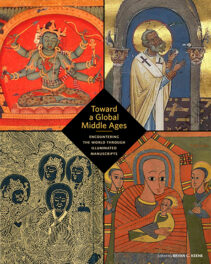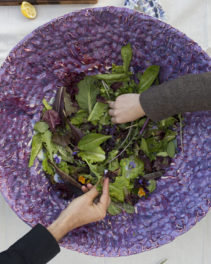
Moses Placed in the River (detail), about 1400–1410, German. Tempera colors, gold, silver paint, and ink on parchment. The J. Paul Getty Museum. Digital image courtesy of the Getty’s Open Content Program
Drawn from the Getty Museum’s manuscript collection and featuring the recently-acquired Rothschild Pentateuch, Painted Prophecy: The Hebrew Bible through Christian Eyes explores the potent narratives of the Hebrew Bible as they were taken and adapted for use in the Christian tradition.
Stories and figures from the Hebrew Bible, known to Christians as the Old Testament, appear in spectacular examples of medieval manuscript painting. The images on view illuminate essential aspects of medieval Christian beliefs and a range of cultural attitudes, including the understanding of history as prophecy, ideas about women in society, and hostilities between Christian and Jewish communities.

Decorated Text Page, 1296, French or German. Tempera colors, gold, and ink, 10 13/16 × 8 1/4 in. The J. Paul Getty Museum, Los Angeles. Acquired with the generous support of Jo Carole and Ronald S. Lauder. Ms. 116, fol. 23

Samson Wrestling with the Lion, about 1270, Franco-Flemish. Tempera colors, gold leaf, and ink on parchment, 7 1/2 × 5 5/8 in. The J. Paul Getty Museum, Los Angeles. Ms. Ludwig XV 3, fol. 67. Digital image courtesy of the Getty’s Open Content Program
Good and Bad Women in Medieval Christian Manuscripts
Medieval depictions of women in Christian manuscripts, couched in imagery from the Old Testament, reflect the ideologies and stereotypes that were intended to guide female behavior. The Hebrew Bible describes and celebrates the exploits of many heroines who were known as religious leaders, prophets, and women who bravely acted to defend their people from enemies.
The figure of Eve, introduced in the book of Genesis as the first mortal woman, is an example of an Old Testament woman who took on new meaning to Christians. Unlike Eve, the Virgin Mary was a redemptive figure. These female types were instrumental in shaping the concepts of good and bad women in the Middle Ages.

Initial L: Esther, about 1300, Austrian. Tempera colors and gold leaf on parchment, 13 1/2 × 9 9/16 in. The J. Paul Getty Museum, Los Angeles. Ms. Ludwig XIII 1, fol. 219. Digital image courtesy of the Getty’s Open Content Program
Prejudice and Discrimination
Though the interpretation of Hebrew scripture formed the foundations of Christian belief during the Middle Ages, Christian attitudes toward Jewish populations living in medieval Europe were fraught. Old Testament figures were held up as examples of both positive and negative behavior, yet anti-Jewish sentiment was widespread. Many images in manuscripts reflect Christian prejudices against Judaism and played a key role in the rise of violent and discriminatory acts against Jews. Examples ranged from forced conversions and laws restricting their activities to expulsions from various countries and mass murders.
Often obscured in the telling of this history are the Jewish communities who practiced their faith throughout the medieval period. A vibrant intellectual, religious, and artistic tradition can be seen in the production of texts and material objects that bear witness to the continued contributions of Jewish writers and thinkers throughout the European Middle Ages. On view from local collections are examples of early Hebrew printing as well as the Rothschild Pentateuch, one of the most elaborate illuminated Hebrew Bibles to survive from the era.
“The objects on view in the exhibition reveal how deeply interconnected Christian and Jewish ideas of the divine were in the Middle Ages, a relationship fostered by the shared sacred text that was foundational to both traditions,” said Larisa Grollemond, Assistant Curator of Manuscripts. “The different interpretations and understanding of that text, seen through the lens of manuscript illumination and the book arts, tell a complex story about the lived experiences and faiths of medieval people.”

The Last Judgment, after 1460, Flemish. Tempera colors, gold leaf, and ink on parchment, 6 3/4 × 4 13/16 in. The J. Paul Getty Museum, Los Angeles. Ms. Ludwig IX 9, fol. 149v
Painted Prophecy: The Hebrew Bible through Christian Eyes is on view March 10–May 31, 2020.




Comments on this post are now closed.